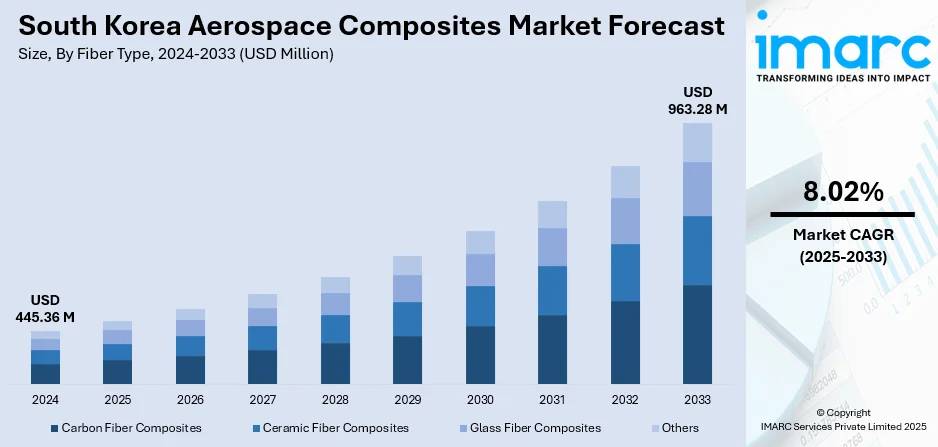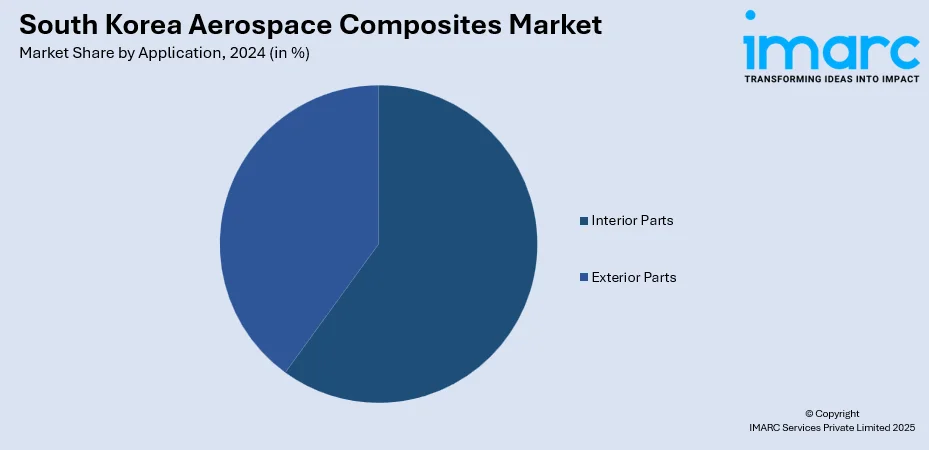
South Korea Aerospace Composites Market Size, Share, Trends and Forecast by Fiber Type, Resin Type, Aircraft Type, Application, Manufacturing Process, and Region, 2025-2033
South Korea Aerospace Composites Market Overview:
The South Korea aerospace composites market size reached USD 445.36 Million in 2024. The market is projected to reach USD 963.28 Million by 2033, exhibiting a growth rate (CAGR) of 8.02% during 2025-2033 At present, the development of next-generation unmanned aerial vehicles (UAVs) is catalyzing the demand for lightweight, durable, and high-performance materials. Besides this, as South Korea is enhancing its national defense capabilities, there is an increasing emphasis on advancing and modernizing fighter jets, helicopters, and reconnaissance planes. This is contributing to the expansion of the South Korea aerospace composites market share.
|
Report Attribute
|
Key Statistics
|
|---|---|
|
Base Year
|
2024
|
|
Forecast Years
|
2025-2033
|
|
Historical Years
|
2019-2024
|
| Market Size in 2024 | USD 445.36 Million |
| Market Forecast in 2033 | USD 963.28 Million |
| Market Growth Rate 2025-2033 | 8.02% |
South Korea Aerospace Composites Market Trends:
Thriving defense sector
As South Korea is strengthening its national defense capabilities, there is a growing focus on developing and upgrading fighter jets, helicopters, and surveillance aircraft. Aerospace composites play a significant role in achieving reduced weight, improved fuel efficiency, and higher structural integrity, which are critical for superior performance in defense operations. These materials offer resistance to harsh environments and reduce maintenance needs, making them ideal for long-term deployment in military applications. The defense sector also requires stealth capabilities and radar-absorbing materials, which composite technologies can deliver effectively. Domestic production of defense aircraft and collaboration with international aerospace and defense companies are further increasing the integration of composites into new platforms. Government agencies are making investments and prioritizing material advancements, catalyzing composite demand. Additionally, efforts to enhance the export potential of defense products are motivating manufacturers to adopt competitive technologies, including composite materials. As South Korea continues to modernize its aerospace and defense fleet and infrastructure, the consistent need for high-performance materials is contributing to the expansion of the market in the country. As per the IMARC Group, the South Korea aerospace and defense market is set to attain USD 28.20 Billion by 2033, exhibiting a CAGR of 6.10% during 2025-2033.

To get more information on this market, Request Sample
Rising development of next-generation UAVs
The development of next-generation UAVs is fueling the South Korea aerospace composites market growth. As South Korea is expanding its focus on drone technology for defense, surveillance, agriculture, and logistics, the need for advanced materials that enhance flight efficiency is becoming more critical. Aerospace composites, including carbon fiber-reinforced polymers, provide exceptional strength-to-weight ratios and resistance to corrosion, making them suitable for UAV structures. These materials help improve fuel efficiency, extend flight time, and support stealth capabilities, which are essential for both military and commercial drones. Research institutions and private aerospace companies are collaborating to develop innovative UAV platforms using cutting-edge composite technologies. Government and private sector initiatives aimed at promoting UAV adoption and investment in defense modernization are also contributing to increased composite utilization. In February 2025, South Korea's Defense Development Agency (ADD) and Korean Air Aerospace Division (KAL-ASD) presented the nation's inaugural collaborative combat aircraft prototype, which they aimed to advance rapidly. ADD announced its goal to carry out the inaugural flight of the low observable wingman UAV. As the UAV industry is growing in scope and complexity, the reliance on advanced aerospace composites is intensifying.
South Korea Aerospace Composites Market Segmentation:
IMARC Group provides an analysis of the key trends in each segment of the market, along with forecasts at the country and regional levels for 2025-2033. Our report has categorized the market based on fiber type, resin type, aircraft type, application, and manufacturing process.
Fiber Type Insights:
- Carbon Fiber Composites
- Ceramic Fiber Composites
- Glass Fiber Composites
- Others
The report has provided a detailed breakup and analysis of the market based on the fiber type. This includes carbon fiber composites, ceramic fiber composites, glass fiber composites, and others.
Resin Type Insights:
- Epoxy
- Phenolic
- Polyester
- Polyimides
- Thermoplastics
- Ceramic and Metal Matrix
- Others
A detailed breakup and analysis of the market based on the resin type have also been provided in the report. This includes epoxy, phenolic, polyester, polyimides, thermoplastics, ceramic and metal matrix, and others.
Aircraft Type Insights:
- Commercial Aircraft
- Business Aviation
- Civil Helicopters
- Military Aircraft and Helicopters
- Others
The report has provided a detailed breakup and analysis of the market based on the aircraft type. This includes commercial aircraft, business aviation, civil helicopters, military aircraft and helicopters, and others.
Application Insights:

- Interior Parts
- Exterior Parts
A detailed breakup and analysis of the market based on the application have also been provided in the report. This includes interior parts and exterior parts.
Manufacturing Process Insights:
- AFP/ATL
- Layup
- RTM/VARTM
- Filament Winding
- Others
The report has provided a detailed breakup and analysis of the market based on the manufacturing process. This includes AFP/ATL, layup, RTM/VARTM, filament winding, and others.
Regional Insights:
- Seoul Capital Area
- Yeongnam (Southeastern Region)
- Honam (Southwestern Region)
- Hoseo (Central Region)
- Others
The report has also provided a comprehensive analysis of all the major regional markets, which include Seoul Capital Area, Yeongnam (Southeastern Region), Honam (Southwestern Region), Hoseo (Central Region), and others.
Competitive Landscape:
The market research report has also provided a comprehensive analysis of the competitive landscape. Competitive analysis such as market structure, key player positioning, top winning strategies, competitive dashboard, and company evaluation quadrant has been covered in the report. Also, detailed profiles of all major companies have been provided.
South Korea Aerospace Composites Market News:
- In April 2025, PERIGEE Aerospace was set to commence South Korea's commercial spaceflight era, as it revealed plans to execute a suborbital test launch by 2025 and attain full-scale commercial launch success by 2026. It obtained hardware contracts for engine tanks, avionics, and satellite thrusters from organizations and firms like the Korea Astronomy and Space Science Institute and Satrec Initiative. PERIGEE's main product was the Blue Whale 1, a two-stage rocket powered by liquid methane. It used carbon composite materials in its design, resulting in a lighter, more cost-effective, and quicker vehicle.
South Korea Aerospace Composites Market Report Coverage:
| Report Features | Details |
|---|---|
| Base Year of the Analysis | 2024 |
| Historical Period | 2019-2024 |
| Forecast Period | 2025-2033 |
| Units | Million USD |
| Scope of the Report |
Exploration of Historical Trends and Market Outlook, Industry Catalysts and Challenges, Segment-Wise Historical and Future Market Assessment:
|
| Fiber Types Covered | Carbon Fiber Composites, Ceramic Fiber Composites, Glass Fiber Composites, Others |
| Resin Types Covered | Epoxy, Phenolic, Polyester, Polyimides, Thermoplastics, Ceramic and Metal Matrix, Others |
| Aircraft Types Covered | Commercial Aircraft, Business Aviation, Civil Helicopters, Military Aircraft and Helicopters, Others |
| Applications Covered | Interior Parts, Exterior Parts |
| Manufacturing Processs Covered | AFP/ATL, Layup, RTM/VARTM, Filament Winding, Others |
| Regions Covered | Seoul Capital Area, Yeongnam (Southeastern Region), Honam (Southwestern Region), Hoseo (Central Region), Others |
| Customization Scope | 10% Free Customization |
| Post-Sale Analyst Support | 10-12 Weeks |
| Delivery Format | PDF and Excel through Email (We can also provide the editable version of the report in PPT/Word format on special request) |
Key Questions Answered in This Report:
- How has the South Korea aerospace composites market performed so far and how will it perform in the coming years?
- What is the breakup of the South Korea aerospace composites market on the basis of fiber type?
- What is the breakup of the South Korea aerospace composites market on the basis of resin type?
- What is the breakup of the South Korea aerospace composites market on the basis of aircraft type?
- What is the breakup of the South Korea aerospace composites market on the basis of application?
- What is the breakup of the South Korea aerospace composites market on the basis of manufacturing process?
- What is the breakup of the South Korea aerospace composites market on the basis of region?
- What are the various stages in the value chain of the South Korea aerospace composites market?
- What are the key driving factors and challenges in the South Korea aerospace composites market?
- What is the structure of the South Korea aerospace composites market and who are the key players?
- What is the degree of competition in the South Korea aerospace composites market?
Key Benefits for Stakeholders:
- IMARC’s industry report offers a comprehensive quantitative analysis of various market segments, historical and current market trends, market forecasts, and dynamics of the South Korea aerospace composites market from 2019-2033.
- The research report provides the latest information on the market drivers, challenges, and opportunities in the South Korea aerospace composites market.
- Porter's five forces analysis assist stakeholders in assessing the impact of new entrants, competitive rivalry, supplier power, buyer power, and the threat of substitution. It helps stakeholders to analyze the level of competition within the South Korea aerospace composites industry and its attractiveness.
- Competitive landscape allows stakeholders to understand their competitive environment and provides an insight into the current positions of key players in the market.
Need more help?
- Speak to our experienced analysts for insights on the current market scenarios.
- Include additional segments and countries to customize the report as per your requirement.
- Gain an unparalleled competitive advantage in your domain by understanding how to utilize the report and positively impacting your operations and revenue.
- For further assistance, please connect with our analysts.
 Request Customization
Request Customization
 Speak to an Analyst
Speak to an Analyst
 Request Brochure
Request Brochure
 Inquire Before Buying
Inquire Before Buying




.webp)




.webp)












